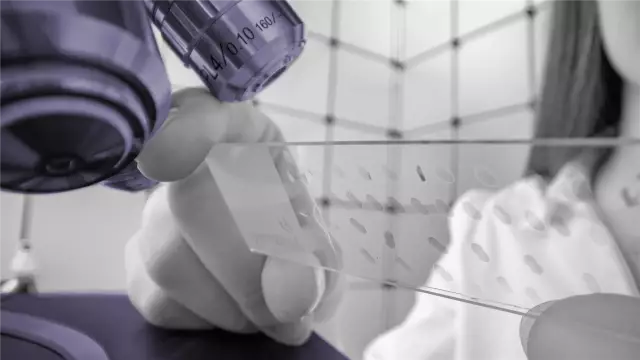- Author Rachel Wainwright [email protected].
- Public 2023-12-15 07:39.
- Last modified 2025-11-02 20:14.
Prostate biopsy

To confirm prostate cancer, to determine the stage of its development, a prostate biopsy is performed: a fragment of the prostate gland is taken for further histological and cytological examination.
Biopsy is performed in three ways:
- under finger control, blindly. The patient is placed on his right side, he draws his legs to the stomach. Local anesthesia is carried out using special anesthetic gels. After that, the doctor carefully inserts a needle into the rectum, while controlling its movement with a finger, and makes 4-6 punctures of the prostate. This diagnostic method is considered outdated and is used less and less due to the lack of control over the procedure.
- Polyfocal biopsy. It is performed under the control of an ultrasound machine. Fragments of the prostate gland are taken from 12 points of the organ.
- Saturation biopsy. It is considered the most advanced and accurate diagnostic method: material for analysis is taken from 24 points of the prostate gland. Thanks to this method, cancer can be detected at an early stage.
Indications for a prostate biopsy
Distinguish between primary and secondary biopsies.
A primary prostate biopsy is done if cancer is suspected:
- with an increased level of prostate-specific antigen - more than 4ng / ml;
- after detecting a zone of low echogenicity in the prostate gland using transrectal or transabdominal ultrasound;
- after identifying a node or seal in the prostate;
Repeat the biopsy if the initial diagnosis was negative and in such cases:
- an increased level of prostate-specific antigen persists and grows;
- antigen density is more than 15%;
- the ratio of free antigen to total is less than 10%;
- high grade prostatic intraepithelial neoplasia was found on primary biopsy;
- during the first study, not enough material was taken.
Considering that a prostate biopsy is not painful, only local anesthesia is practiced - using cathejel, lidocaine gel and other similar drugs. Intravenous anesthesia is allowed in rare cases, because this can cause complications.
Prostate biopsy can only be done with the patient's consent.
Preparing for a biopsy
Before the biopsy, the patient undergoes various examinations: he donates blood for a general analysis, urine for culture for flora and a general analysis. If the patient was taking anticoagulants, they should be discontinued a week before the biopsy: heparin, aspirin, thrombostop, fraxiparin, syncumar and tested for prothrombin index and time. If drugs cannot be stopped, prostate biopsy should be done in a hospital setting.

It is undesirable to have dinner on the eve of the procedure; a light breakfast is allowed on the day of the biopsy. In addition, on the eve of the biopsy, a cleansing enema is done in the evening and in the morning. If necessary and according to a doctor's recommendation, the patient takes antibiotics 24 hours before the procedure and another 3-4 days after the biopsy.
Contraindications to biopsy
Prostate biopsy should not be performed if there is acute inflammation, bleeding, feces, or acute prostatitis in the rectum.
Complications of prostate biopsy
Despite the fact that the biopsy is performed in most cases on an outpatient basis, it is advisable to arrange a sick leave on the day of the procedure.
After a biopsy of the prostate, complications rarely develop: blood in the feces and urine, fever, difficulty urinating, inflammation of the testicles, epididymis and prostate gland, loss of consciousness, bleeding from the rectum, and blood poisoning may occur.
If complications do arise from a prostate biopsy, you should see a doctor immediately.
Found a mistake in the text? Select it and press Ctrl + Enter.






